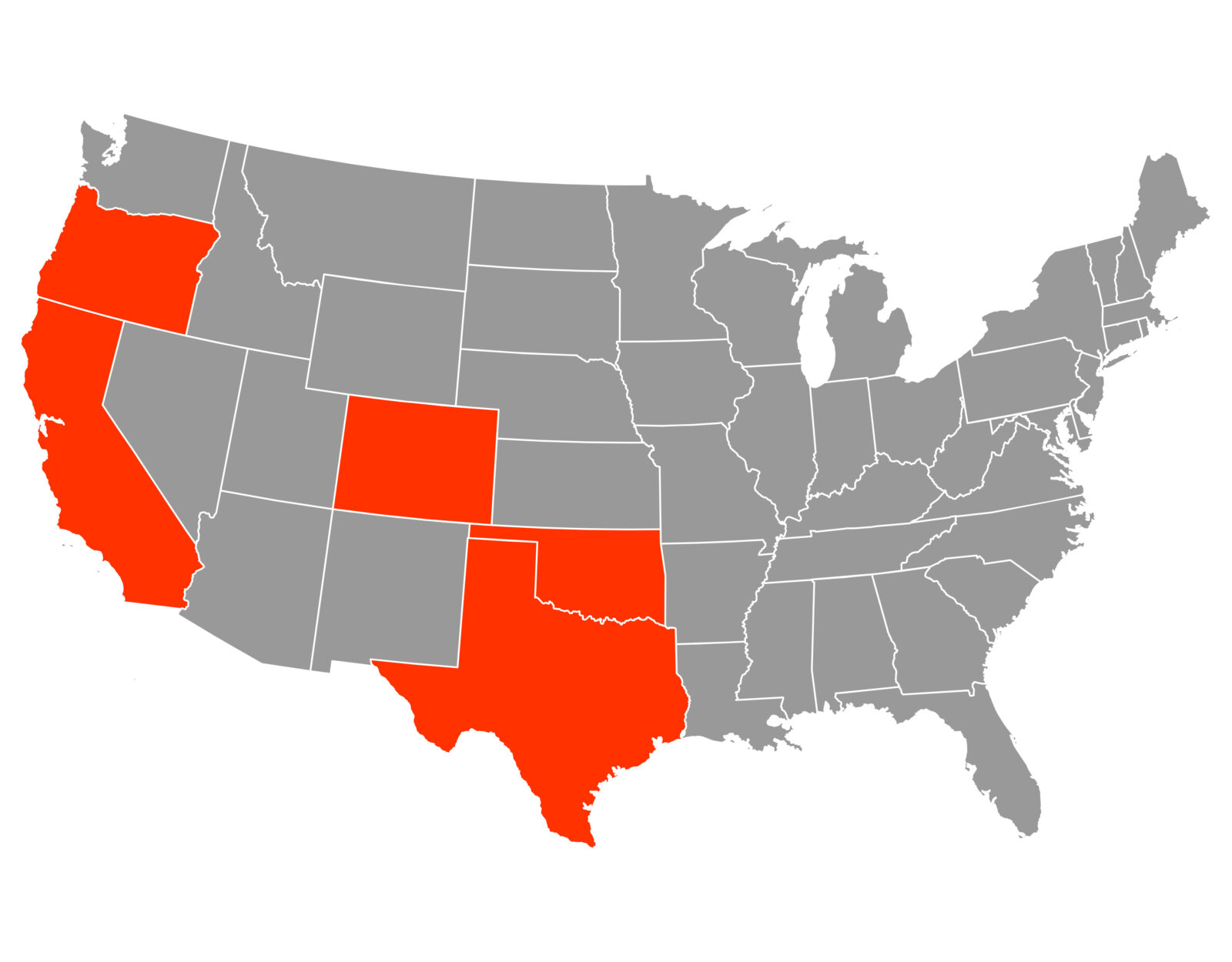The tan-tipped tail feathers of the Rio Grande wild turkey distinguish them from other subspecies. They’re not very big birds, topping out between 18-20 pounds, but they have sharp spurs and love to roam. You’ll find Rios in mostly open scrublands of Texas, Oklahoma, and Kansas. Although some have been transplanted to California, Oregon, and even Hawaii. As a hunting tactic, these turkeys like to return to the same roost every evening, so once you find out where that is stay on them, and like the Merriam’s, Rio Grandes can be easy to call and are very vocal in the daytime.
Top States for Rio Grande Wild Turkeys

California
Where the Rio Grandes Have Made a Home
California is a big state, and turkey populations cover about one-fifth of it. The Rio Grande subspecies is by far the most established here, but you can also find Merriam’s, easterns, and even hybrids. Add to this the fact that the average hunter success rate is 40% and higher for turkey hunts, there’s a three-bird limit in the spring, and you have a great state for chasing toms. Plus, the turkey populations are generally expanding across the state.
Local Intel: Born and Raised’s Kody Kellom
“In all my travels, California has the greatest population of turkeys I’ve ever seen. The Merriam’s can be found high in the mountains or Rio Grandes low in the northern and central valleys and foothills. Access can be tricky in the lower country, as much of the area is private land, but there are some great opportunities for the public both via walk-in or boat-in access. Covering ground via boat can be a great tactic that gets you away from the crowds.
“California’s license system is unique as they don’t require a tag for turkeys, but a small game license covers your daily limit of one male turkey, and up to three per year in the spring season. The season starts the last Saturday in March and runs for approximately five weeks, giving you ample time to get your birds. Also, they have a youth-only season along with an archery only season. Another opportunity that California offers is a CDFW’s SHARE program, allowing public hunting on some select private lands. For more details on these hunts, visit wildlife.ca.gov/hunting/SHARE.”
Take a closer look at California:
CA Regs
Colorado
Where You Can Build Points or Buy OTC
Colorado gives turkey hunters opportunities. Through over-the-counter (OTC) tags or through a special draw, bagging a Rio Grande (or a Merriam’s) can be done. Colorado has steep, mountainous terrain as well as open expanses. Be ready to put some miles on your boots, either in the hills or along the river bottoms. However, with over 35,000 turkeys to chase, you might be lucky this season.
Local Intel: onX’s Own Paul Ronto
“Colorado is a fantastic state to chase animals around, which is why so many people want to come here to hunt in our stunning mountains. From big game, to waterfowl, to turkeys, Colorado has it all. As waterfowl ends in later winter, there’s only a few weeks before the spring turkey hunt is on.
“What’s great about Colorado is we have two distinct landscapes. Our western mountains offer amazing habitat for Merriam’s, as you can call birds in the hills, but the landscape tends to be more productive for the run-and-gun style spot-and-stalk hunters.
“Those of you who love chasing elk around will appreciate the similarities to the spring Merriam’s hunt here in Colorado. In the spring, follow the snow line, and as temps warm the birds tend to leave the bottoms and head for the ridges. For anyone wanting to sit and call a bit more, you’re in luck, Colorado’s eastern plains have an abundant Rio Grande turkey population that’s a bit more predictable than the mountain-loving Merriam’s. The Rios tend to hang out in the popular-choked river bottoms, and the landscape is considerably easier to navigate. Trade your hiking boots and binoculars for waders and decoys and you’ll be on birds throughout the day.
“Colorado has a point system for turkeys, but there are plenty of OTC tags as well. You can apply for both spring and fall hunts, and compile two points a year. This is great news for anyone looking for a premium hunt which takes 3-5 points, so every year or two you can realistically apply for a limited unit.”
Take a closer look at Colorado:
CO Regs

25% Off Ol’ Tom
Get your new go-to turkey gear this spring from Ol’ Tom and save 25% off as an onX Elite Member.
Oklahoma
It’s Worth the Drive
Even moving from a three-turkey bag limit down to one in 2022, turkey hunting in Oklahoma is a good state to find Rio Grandes, which inhabit most of the state. You’ll find easterns and hybrids here too. The spring season opening date has also been moved back 10 days to protect mature toms during peak breeding. One of the main culprits behind the decline in Rio Grande turkey populations has been drought.
Wildlife managers and hunters are enthusiastic about the potential of turning around these declines in the next three to five years. This means keeping Oklahoma on your radar now and going forward.
Local Intel: Land and Legacy’s Matt Dye
“The Oklahoma eco-regions vary greatly across the state from east to west. This makes the situations a turkey hunter can find themselves in vary depending on the location. But one thing does remain consistent across the state and that is the need for proper ‘strut zones’ during the season. Most hunters don’t see this to be limiting, but depending on the region of the state or timing of the season this can greatly influence where a tom can and cannot strut easily. For instance, the prairie regions of the west and central portions of the state may have tall native grasses still standing from last year. The Cross-Timbers region may have thick greenbrier pockets, or the various bottomland timbered portions of the state may have native cool-season grasses already growing tall during the second half of season.
“The key is, when you find a gobbler on the roost, take close notice to the surrounding areas to anticipate where he is going to fly down and strut. Recently grazed pastures, hay fields, wheat fields, sandy soil deposits, and oil field roads are likely locations to set up on to intercept a long beard in Oklahoma. Another key component to look for during the later portion of the season is to find the shade. This is where you will find midday gobblers loafing. The sun can beat down and warm things up quickly in the Sooner State.”
Local Intel: onX’s Own Ben Brettingen
“The Sooner State has traditionally been a great destination for finding a spring gobbler. In the early 2000s hunters harvested around 40,000 birds but have seen declines in recent decades. In 2021, hunters harvested half of that number, 19,000 birds.
“Eric Shuttles of the Oklahoma Department of Wildlife Conservation says, ‘In Oklahoma, wild turkey populations have declined over the past three years in all five regions where surveys are conducted. Those three-year declines range from 2.7 percent in the Northeast Region to a whopping 67.1 percent in the Southwest Region.’
“To address these issues, Oklahoma has reduced the bag limit and shortened the season. Even though the populations aren’t what they used to be, Oklahoma is still worthwhile hunting. With a number of large public land tracts, there are birds to still be had.
“Oklahoma is a very diverse state, and having the ability to hunt different subspecies of birds in these different regions is pretty incredible. Central Oklahoma boasts the highest number of birds and hasn’t seen the precipitous decline the western areas are facing.”
Take a closer look at Oklahoma:
OK Regs
Oregon
Look for Longbeards on Logging Roads
Turkey hunting in Oregon seems to be on the upswing. The 2020 season harvest numbers were the highest recorded, and 2021’s numbers were the second highest. Then 2023 brought the fourth-highest harvest in the state’s history. The hunting is good here, but particularly good in the southwest part of the state. Southwest Oregon is the leading place to find turkeys. The Rogue, Melrose, and Applegate units have had the highest turkey harvests in Oregon. The state also has a six-week spring season; one of the most liberal in the country.

Local Intel: Born and Raised’s Kody Kellom
“The turkey population in Oregon has been on the increase since the late 90s. The Oregon Department of Fish and Wildlife and the NWTF have done some amazing transplant projects expanding their range into almost every county of the state. The majority of the birds you will find on the west side of the state are Rio Grandes. The southwest corner of the state has been the stronghold of the population and it has been used for the expansion projects by ODFW and NWTF. There is also a stronghold of gobblers in the northeast portion of the state, with vast plots of public land or private timberlands open to public hunting opportunities.
Another region that holds a lot of birds contains the White River and Ochocco units. This area tends to have the highest pressure in the state, but the population is strong and hunters have a good chance of filling their tag there. The nice thing about Oregon is that the season runs six weeks, from April 15 through May 31, giving you ample time to find a longbeard.
“Over the years, the best tactics for locating these birds is covering the logging road systems and looking for sign. Once you locate an area that is holding some birds, concentrate on logged areas that have good habitat. They tend to roost in the same areas year after year so keep that intel recorded in your Hunt App. Don’t be afraid to use a crow call, coyote howler, or goose call to shock gobble the birds in these large canyons. Those locator sounds travel far and you can often hear gobbles from over a mile away.”
Local Intel: Higdon Outdoors’ Beau Brooks
“Growing up on the Washington/Oregon border, I spent my whole life hunting turkeys in Oregon. This state has so many opportunities to hunt turkeys. The state is composed of roughly 80% public land, but that doesn’t mean there will be turkeys in all of it. The turkeys in the eastern half of the state, especially as the snow melts, become very ‘pockety.’ Plan to drive the roads with a box call all day locating birds.
“Early season you can find the birds congregated on the snow line. They follow the snow up the mountains and spread out as the season pushes on. May, after they spread out, can be the best time to hunt these birds because they will no longer have hens. The southwest part of the state is by far the most populated, but there is a lot of private land. If you’re willing to work there are public land opportunities in this area and it will be by far the most turkeys in the state.
“That being said, these turkeys are true mountain turkeys so plan to hear a lot of gobbling and hike a bunch! It is definitely one of the prettiest places I have ever hunted Rios. If you have never been to Oregon I would suggest hunting the southeast corner. It truly has an impressive population.”
Take a closer look at Oregon:
OR Regs
Texas
You’ll Want Private Land Access
Texas, for several years, has been viewed as, to put it delicately, a “honey hole” turkey state. To put it not so delicately, it has been viewed as an easy place to go and kill a turkey. A lay up hunt, so to speak. Much of this reputation was earned in the 90s and early 2000s when it became a popular destination for hunting television shows, outdoor writer hunts, and other sorts of similar media. It was also viewed this way because of the truly impressive number of turkeys that called Texas home, and the populations seems to only be increasing.
This has had a significant effect on both the hunting quality in some instances and the ability to get hunting access. Texas is on the extremely low-end of the spectrum when it comes to public hunting availability. So, as you could imagine, these areas get hunted a lot. On the private land side, it didn’t take long for landowners to realize the value in turkey hunting opportunities, so the days of free access are virtually gone and the price of leases and outfitters has only continued to climb. Needless to say, if you’re a turkey hunter, Texas is still a state you need to visit. It earned that reputation for a reason. Just know going in that to have the type of hunt that you’ve heard folks lament about, you’re likely going to have to pay for that type of access.
Local Intel: onX’s Own Ben Brettingen
“Texas is a perennial powerhouse when it comes to turkey hunting and consistently ranks near the top for turkey harvest. Turkeys in Texas do not see the pressure like in many other states due to the significant amount of private land.
“It’s a double-edged sword. If you’re able to gain access to hunt gobblers in Texas your odds of success are very high, but there just aren’t the public land opportunities found in many other states. A lot of land is leased for deer or quail hunting, and this has been a great opportunity for me to be able to access these lands for chasing turkeys.
“Areas such as the Edwards Plateau, and the Rolling Plains have traditionally been go-to destinations for spring gobblers, having some of the highest densities and production.”
Take a closer look at Texas:
TX Regs
